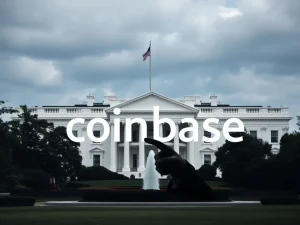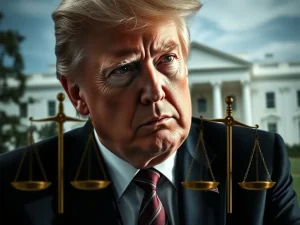Revolutionary: Trump’s Executive Order Paves Way for Crypto in 401k Retirement Plans

Are you a US worker considering your retirement savings? A significant shift could soon reshape how Americans invest. President Donald Trump is preparing to sign an executive order allowing exposure to crypto in 401k retirement plans. This move marks a potentially transformative moment for digital assets within mainstream finance.
A New Era for Crypto in 401k Retirement Plans
The White House Press Office recently confirmed a major policy change to Crypto News Insights. President Trump will sign an executive order allowing US workers to gain exposure to cryptocurrencies through their 401(k) retirement plans. This directive could significantly alter the landscape for American savers and the broader digital asset market.
Specifically, the order instructs the US Labor Department to reevaluate existing restrictions. These restrictions cover alternative assets within defined-contribution plans. This includes digital assets, private equity, and real estate. Consequently, millions of Americans might soon access a new range of investment opportunities.
A senior White House official elaborated on the order’s scope. It directs the Secretary of Labor to clarify the department’s stance on alternative assets. Furthermore, it seeks to provide clear guidance on fiduciary processes. This guidance is crucial for offering these types of investments in retirement portfolios. Ultimately, this aims to provide a clearer path for financial advisors and plan administrators.
Unlocking the $12.5 Trillion Retirement Market
This executive order opens the door to a massive financial opportunity. Once implemented, it could grant Americans access to digital assets through their 401(k) plans. This market alone accounts for a staggering $12.5 trillion in retirement savings. Therefore, it represents a highly sought-after opportunity for crypto firms. They aim to reach more retail investors and broaden adoption.
The move signifies a substantial step forward for the entire crypto industry. The industry has long pursued wider retail exposure and greater financial system legitimacy. Previously, everyday savers faced significant barriers. These included concerns about fiduciary risk, regulatory uncertainty, and asset volatility. However, institutional investors have increasingly allocated funds to crypto. This new policy could bridge the gap for individual investors.
Consider the potential impact:
- Increased Accessibility: Millions of US workers could easily invest in crypto.
- Mainstream Legitimacy: Inclusion in 401(k)s boosts crypto’s standing.
- Market Growth: A significant influx of capital into the digital asset space.
- Diversification Opportunities: Savers gain new options for portfolio diversification.
This policy change could truly reshape how Americans approach their long-term savings.
Navigating Regulatory Waters: Trump Crypto Policy
President Trump’s directive also calls for extensive inter-agency coordination. This collaboration will involve the US Treasury and the Securities and Exchange Commission (SEC). Their joint effort will explore necessary rule changes. These changes are vital to support the adoption of alternative investments like crypto in retirement products. This collaborative approach highlights the complexity of integrating digital assets into traditional financial frameworks.
The idea of allowing alternative investments in 401(k) plans has circulated for some time. On July 18, the Financial Times cited anonymous sources regarding the president’s interest in such assets. White House spokesman Kush Desai previously stated that no decisions are official until President Trump himself confirms them. Desai emphasized Trump’s commitment to restoring prosperity for everyday Americans. He also underscored the importance of safeguarding their economic future. This ensures that the final decision rests with the President.
The Evolving Stance on Digital Assets 401k
The regulatory environment surrounding digital assets 401k has been dynamic. Earlier this year, the Labor Department rescinded a previous guidance concerning crypto in 401(k) plans. Specifically, on May 28, the Labor Department revoked a 2022 guidance. This earlier guidance had urged fiduciaries to exercise “extremely cautious” when considering crypto for retirement plans. This reversal indicates a shift towards a more open stance regarding digital asset inclusion.
SEC Chair Paul Atkins also shared his perspective during a Bloomberg interview. Atkins stressed the crucial need for education on the risks associated with crypto investments. He stated that clear disclosure is key. People must be fully aware of what they are getting into before investing. Atkins expressed anticipation for the president’s upcoming actions. His comments underscore the ongoing balance between innovation and investor protection.
Implications for US Crypto Policy and Future Investments
This executive order represents a landmark moment for US crypto policy. It signals a strong intent to integrate digital assets more deeply into the nation’s financial system. For retail investors, this means easier access to a growing asset class. It also offers potential diversification benefits for retirement portfolios. This move could encourage more widespread adoption of cryptocurrencies beyond current enthusiasts.
The administration’s focus on alternative assets reflects a broader trend. Investors seek new avenues for growth and inflation hedging. As regulatory clarity improves, the integration of crypto into traditional investment vehicles becomes more feasible. This policy shift could pave the way for further innovation in financial products. It also suggests a more accommodating regulatory approach for digital assets in the future.
In conclusion, President Trump’s executive order could fundamentally change how Americans save for retirement. It provides a significant boost to the legitimacy and accessibility of cryptocurrencies. This development promises to reshape the investment landscape for millions of US workers, ushering in a new era for digital assets in mainstream finance.








